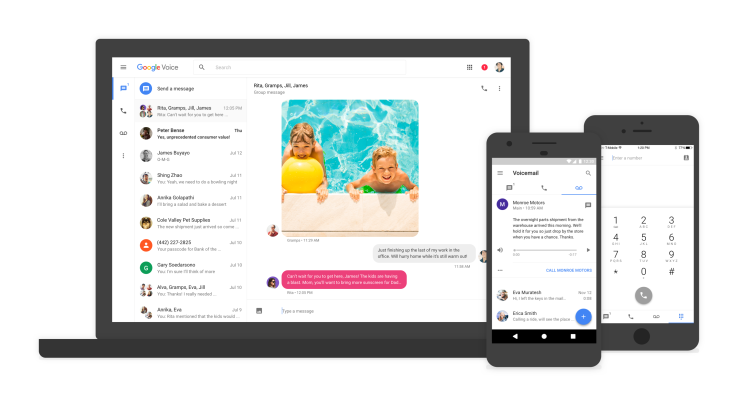

Confirming reports from earlier this month that a Google Voice update was in the works, Google today has launched a refreshed version of its VoIP calling service on mobile and the web. Largely, the update is about giving the product a more modern look-and-feel, after having not received a major upgrade in years. But the relaunch also includes a few new features, like support for photo-sharing, group conversations, Spanish-language voicemail transcription, and more.
In the new app, the Google Voice inbox has separate tabs for your text messages, calls and voicemail, explains Google in its blog post about the update. Your conversations will now stay in one continuous thread, which makes it easier to keep up with the messages from your contacts in a single place.
Meanwhile, the new Google Voice feels more like a viable alternative to your default messaging client, as you can now participate in group conversations and send photo MMS messages. Threaded conversations are supported too, and Google is working with mobile operators to bring rich messaging through RCS to its users in the future.

RCS, as you may recall, was recently rolled out to Android phones on Sprint and Rogers‘ networks, allowing customers to take advantage of this next-gen SMS technology. This enhanced messaging experience includes features that rival iMessage, like group chats where you can name the group, add or remove members, as well as things like read receipts and typing indicators.
Google also notes that the Hangouts integration with Google Voice has not changed with the relaunch. That is, if you prefer to use Hangout as your messaging app, you may continue to do so. (This is the default setting during setup of Google Voice’s new app.) But you do have the option to disconnect Hangouts, to keep the apps separate.

The update comes at a time when Google’s messaging strategy is in flux. While on the one hand, it’s trying to make its default Messenger app more iMessage-like with support for RCS, it also maintains Hangouts (but is now shifting its focus toward the enterprise), and it launched two new apps aimed at consumers, messaging app Allo and FaceTime rival Duo. But that means there’s also a lot of overlap in Google’s products today, which can be confusing.
That said, many Google Voice users had been disappointed to see this simple but useful calling app ignored, but didn’t want to shift to Hangouts. Google finally heeded those concerns, and decided to give Google Voice another shot.
In addition to the visual overhaul, the company has been investing in improvements to the underlying infrastructure, which means these new apps will also offer better voicemail transcriptions, better call quality and reliability, and other improvements.
The updated Google Voice is launching in a phased rollout, and will reach 100 percent of users in a couple of weeks.
Android will receive the update first, followed by iOS. Web will be made available to those who have an updated mobile app first, so the experience remains consistent across devices.

